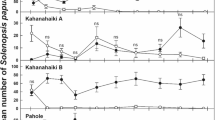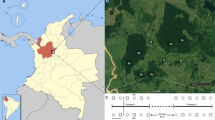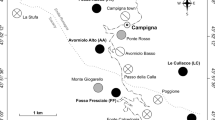Abstract
Pheidole megacephala is an exotic ant species that has severely affected native invertebrate biodiversity throughout the tropics. Its impacts have been documented extensively in relatively depauperate invertebrate communities, but not in species-rich habitats such as tropical rain forests. Here we describe the local distribution of P. megacephala and its impacts on native invertebrate assemblages in and around a rain forest patch at Howard Springs, in Australia's monsoonal tropics. P. megacephala was found to be confined to a single area of approximately 25 ha, with its distribution centered on drainage lines and the rain forest. Significant but weak correlations were found between its abundance and vegetative canopy cover (positive) and distance from the rain forest (negative). In the most heavily infested area within the rain forest, the abundance of P. megacephala was 37–110 times that of total native ant abundance found within uninfested plots, as measured by pitfall traps. The abundance and richness of native ants and other invertebrates were significantly reduced in litter samples, pitfall catches and foliage beats where P. megacephala was present, inversely relative to the abundance of P. megacephala. Only two individuals of a single native ant species were found within the most infested plot, with native ant richness being reduced to about half in the least infested plot. The most persistent functional groups of native ants in infested plots were Cryptic species, which forage primarily within soil and leaf litter, and Opportunists, which exhibit highly generalised foraging behaviour. The highest abundance of P. megacephala corresponded with a 42–85% decrease in the abundance of other native invertebrates. Insect larvae were totally absent from foliage beats collected at the most heavily infested plot. P. megacephala was found overall to be expanding its range, averaging 12 m range expansion in the dry season and contracting 7 m in the wet season. It is able to spread into surrounding savanna habitats by occupying relatively sheltered microsites, such as beneath logs and at the bases of trees. However, it is unlikely to attain high population densities in open savanna habitats because of its relative intolerance of desiccation, and the prevalence of behaviourally dominant native ant species. Howard Springs is currently the only rain forest patch in monsoonal Australia known to be infested by P. megacephala, but clearly this ant is a serious potential threat to the region's rain forest invertebrate fauna.
Similar content being viewed by others
Author information
Authors and Affiliations
Additional information
Received: 19 August 1998 / Accepted: 12 May 1999
Rights and permissions
About this article
Cite this article
Hoffmann, B., Andersen, A. & Hill, G. Impact of an introduced ant on native rain forest invertebrates: Pheidole megacephala in monsoonal Australia. Oecologia 120, 595–604 (1999). https://doi.org/10.1007/PL00008824
Issue Date:
DOI: https://doi.org/10.1007/PL00008824




